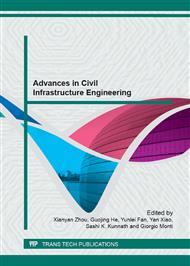p.700
p.704
p.708
p.714
p.721
p.727
p.732
p.740
p.745
Analysis on Heat Transfer Intensity of Bamboo Structure Wall in Warm and Humid Environment
Abstract:
Based on the fundamentals of heat and moisture transfer in porous media, characteristics of heat transfer intensity of a bamboo structure wall are analyzed when the moisture content changes under the action of natural warm and humid environment. The results show that: when the moisture content changes, the effective coefficient of heat conductivity and specific heat capacity of bamboo both change, and physical parameters (e.g., heat transfer capacity, heat storage capacity, temperature distribution, attenuation coefficient of temperature wave, delay coefficient of temperature wave) all change accordingly. When the total moisture content of the wall increases, the temperature difference between inside and outside surfaces of the wall is reduced, and attenuation and delay coefficient of temperature wave both increase. All of these improve the thermal comfort of indoor environment, but the heat transfer capacity through the wall increases. If the total moisture content of the wall is constant and the moisture distribution along the thickness direction of the wall changes, the temperature gradient decreases and the heat storage coefficient increases in bamboo layer of high moisture content, and the temperature gradient increases and the heat storage coefficient decreases in bamboo layer of low moisture content.
Info:
Periodical:
Pages:
721-726
Citation:
Online since:
January 2013
Authors:
Price:
Сopyright:
© 2013 Trans Tech Publications Ltd. All Rights Reserved
Share:
Citation:


